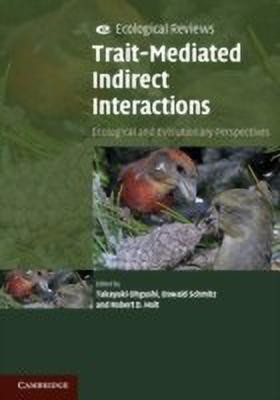Trait-Mediated Indirect Interactions - Ecological and Evolutionary Perspectives(English, Paperback, unknown)
Quick Overview
Product Price Comparison
There is increasing evidence that the structure and functioning of ecological communities and ecosystems are strongly influenced by flexible traits of individuals within species. A deep understanding of how trait flexibility alters direct and indirect species interactions is crucial for addressing key issues in basic and applied ecology. This book provides an integrated perspective on the ecological and evolutionary consequences of interactions mediated by flexible species traits across a wide range of systems. It is the first volume synthesizing the rapidly expanding research field of trait-mediated indirect effects and highlights how the conceptual framework of these effects can aid the understanding of evolutionary processes, population dynamics, community structure and stability, and ecosystem function. It not only brings out the importance of this emerging field for basic ecological questions, but also explores the implications of trait-mediated interactions for the conservation of biodiversity and the response of ecosystems to anthropogenic environmental changes. Table of Contents List of contributors Foreword Preface 1. Introduction Part I. Community: 2. Perspective: kinds of trait-mediated indirect effects in ecological communities: a synthesis 3. Consequences of trait changes in host-parasitoid interactions in insect communities 4. The impact of trait-mediated indirect interactions in marine communities 5. Trait-mediated indirect interactions in size-structured populations: causes and consequences for species interactions and community dynamics 6. Trait-mediated effects, density dependence, and the dynamic stability of ecological systems 7. Plant effects on herbivore-enemy interactions in natural systems 8. The implications of adaptive prey behavior for ecological communities: a review of current theory 9. Community consequences of phenotypic plasticity of terrestrial plants: herbivore-initiated bottom-up trophic cascades 10. Model-based, response surface approaches to quantifying indirect interactions Part II. Coevolution: 11. Perspective: trait-mediated indirect interactions and the coevolutionary process 12. Evolutionary indirect effects: examples from introduced plant and herbivore interactions 13. Indirect evolutionary interactions in a multi-trophic system 14. The role of trait-mediated indirect interactions for multispecies plant-animal mutualisms 15. Consequences of trait evolution in a multi-species system Part III. Ecosystem: 16. Perspective: interspecific indirect genetic effects (IIGEs): linking genetics and genomics to community ecology and ecosystem processes 17. Species functional traits, trophic control, and the ecosystem consequences of adaptive foraging in the middle of food chains 18. Effects of herbivores on terrestrial ecosystem processes: the role of trait mediated indirect effects 19. Functional and heritable consequences of plant genotype on community composition and ecosystem processes 20. Microbial mutualists and biodiversity in ecosystems 21. Integrating trait-mediated effects and non-trophic interactions in the study of biodiversity and ecosystem functioning Part IV. Applied Ecology: 22. Perspective: consequences of trait-mediated indirect interactions for biological control of plant pests 23. Natural enemy functional identity, trait-mediated interactions, and biological control 24. Trait-mediated effects modify patch-size density relationships in insect herbivores and parasitoids 25. Plasticity and trait-mediated indirect interactions among plants 26. Climate change, phenology, and the nature of consumer-resource interactions: advancing the match/mismatch hypothesis 27. Coda Index.


